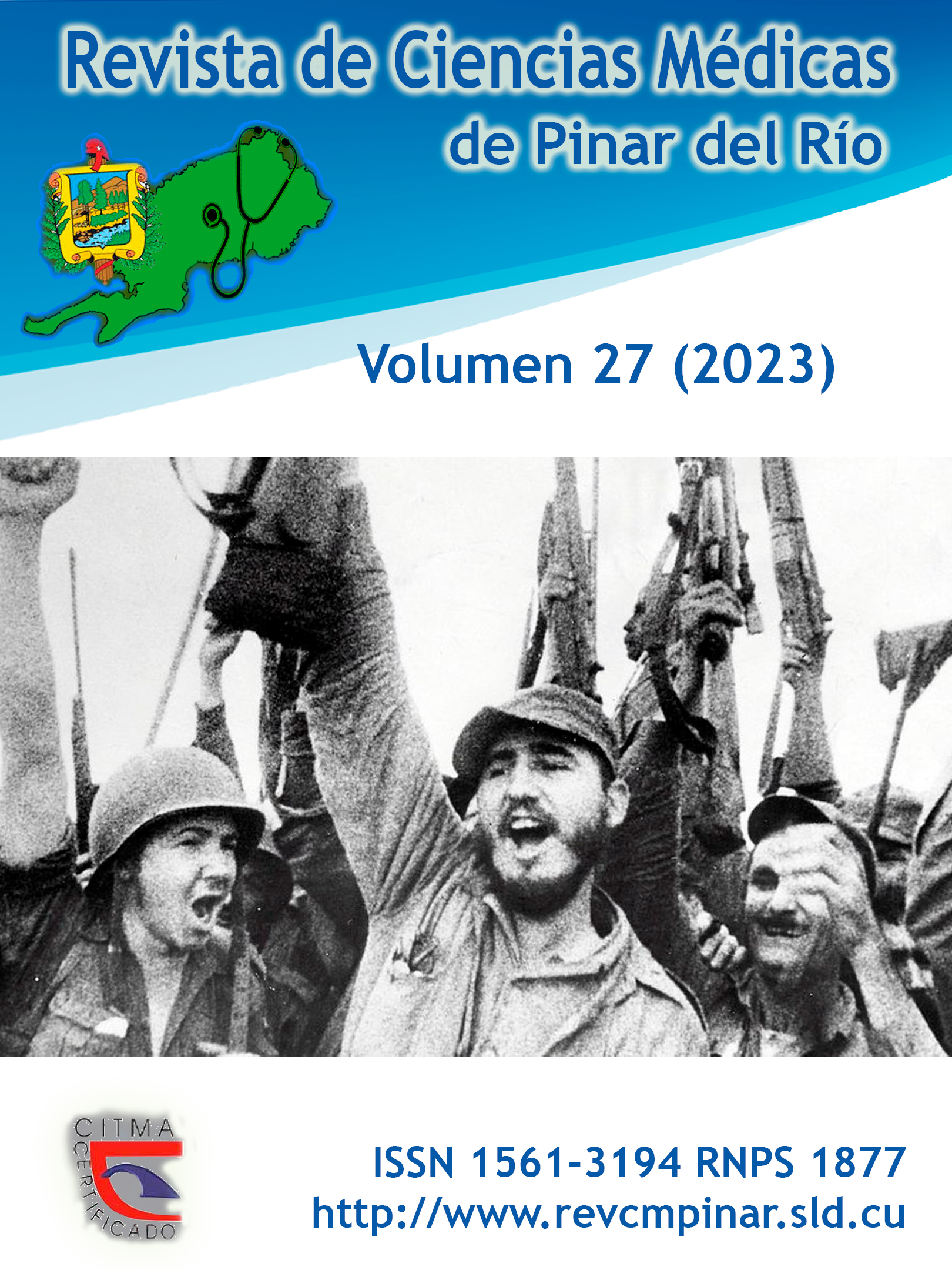Clinical Epidemiological Characterization of Patients with Suspected Human Leptospirosis
Keywords:
LEPTOSPIROSIS, DIAGNOSIS, VACCINES, SIGNS AND SYMPTOMS, RISK FACTORS.Abstract
Introduction: leptospirosis, historically considered the zoonosis of greater international diffusion.
Objective: to characterize clinically and epidemiologically the patients with suspected human leptospirosis in the Hermanos Cruz academic Polyclinic of Pinar del Río during the period 2019- 2021.
Methods: an observational, descriptive and transversal study was carried out. The universe consisted of 182 patients notified by the clinics, the on-call department of the polyclinic and the hospitals. The sample was selected by simple random sampling and consisted of 162 patients. From the ethical point of view, this research complied with the ethical principles contained in the Declaration of Helsinki.
Results: in the research, the age group 40-49 predominated in 71 patients (43,83 %), with a predominance of men (76,46 %). Peasants were the most frequent with 89 cases (54,94 %). The clinical manifestations present were high fever, myalgias and arthralgias in 100 %. As epidemiological risk, rice cultivation predominated with 86 cases (53,09 %).
Conclusions: given the prevalence of patients with suspected human leptospirosis in the sample studied, the norms and procedures for better preventive control of these patients should be strengthened in primary health care, which would lead to a better polyclinic-hospital linkage and thus result in better care and a better quality of life for both the patient and the family.
Downloads
References
1. Hernández Cabezas M, Mauri Pérez JL, Vargas Yzquierdo J, Hernández Cabezas M. Leptospirosis humana: un abordaje epidemiológico desde los factores ambientales. Rev Cubana Med Gen Integr [Internet]. 2017 Mar [citado 14/04/2022]; 33(1): 129-138. Disponible en: http://scielo.sld.cu/scielo.php?script=sci_arttext&pid=S0864-21252017000100011&lng=es
2. Obregón Fuentes A M. Avances de laboratorio sobre la leptospirosis humana en Cuba, 1989-2016. Rev Cubana Med Trop [Internet]. 2017 Dic [citado 14/04/2022]; 69(3): 1-18. Disponible en: http://scielo.sld.cu/scielo.php?script=sci_arttext&pid=S0375-07602017000300013&lng=es
3. Vera Reyna M , Vázquez Fiffe N , Tudela Nápoles T , Mendoza Ramírez M , Delgado Delgado ME. Nivel de conocimientos clínico-epidemiológicos de la leptospirosis en estudiantes. Rev. inf. cient. [Internet]. 2018 Jun [citado 02/08/2021]; 97(3): 566-573. Disponible en: http://scieloprueba.sld.cu/scielo.php?script=sci_arttext&pid=S1028-99332018000300566&lng=es.
4. Ramírez Rodríguez M, Verdasquera Corcho D, Sanabria Ramos, Cabezas Alfonso, Martínez Vizcaíno N, Mena Ramírez M. Manifestaciones tendenciales del conocimiento sobre participación comunitaria en líderes para la prevención de la leptospirosis. AMC [Internet]. 2017 [citado 14/04/2022]; 21(2): 237-245. Disponible en: https://www.redalyc.org/articulo.oa?id=211150128007 .
5. Ramírez-Rodríguez M, Casanova-Moreno MC, Izquierdo-Machín E, César-Nobre-Gómes M A, -Reyes F. Guía para evaluar participación comunitaria en el Programa Nacional de Prevención y Control de Leptospirosis. AMC [Internet]. 2020 Dic [citado 02/08/2021]; 24(6): e7671. Disponible en: https://www.medigraphic.com/cgi-bin/new/resumen.cgi?IDARTICULO=99751
6. Díaz Alfonso H; Padrón González O; Lorenzo Díaz JC. Leptospirosis humana: una estrategia de superación. Revista de Ciencias Médicas[Internet]. 2017[citado 02/08/2021]; 22(1): 133-141. Disponible en: https://revcmpinar.sld.cu/index.php/publicaciones/article/view/3285
7. Cuba. Ministerio de Salud Pública. Anuario Estadístico de Salud 2019. La Habana: MINSAP; 2020 [citado 20/04/2022]. Disponible en: https://temas.sld.cu/estadisticassalud/2020/05/13/publicado-el-anuario-estadistico-de-salud-2019/
8. Mesa Coello L, Machado Díaz B, Llerena González MM, Díaz Muñoz Y, Estupiñan Martínez OR. Caracterización del grupo riesgo de leptospirosis en un consultorio médico de la familia. Acta Médica del Centro [Internet]. 2014 [citado 2020 Jun 23]; 8(3): [aprox. 6 p.]. Disponible en: http://www.revactamedicacentro.sld.cu/index.php/amc/article/view/149
9. Hernández Rodríguez P, Pabón Ludy C, Rodríguez Martha F. Leptospirosis, una zoonosis que impacta a la salud: diagnóstico, tratamiento y nuevas alternativas de control. Rev Cubana MedTrop [Internet]. 2021 Abr [citado 14/04/2022]; 73(1): e509. Disponible en: http://scielo.sld.cu/scielo.php?script=sci_arttext&pid=S0375-07602021000100015&lng=es
10. Mendoza Sánchez X, Martínez De La Rosa W, Parra Corzo D L, Rodríguez Sanjuan A, Varela Prieto Lourdes L, Lagares Guzmán A. Presence of Pathogenic Leptospira spp. in an Urban Slum of the Colombian Caribbean: A One Health Approach. Rev Cubana Med Trop [Internet]. 2020 Dic [citado 02/08/2021]; 72(3): e523. Disponible en: http://scieloprueba.sld.cu/scielo.php?script=sci_arttext&pid=S0375-07602020000300002&lng=es.
11. García Portela R. Estudio clínico y epidemiológico de la Leptospirosis en Pinar del Río (Tesis Doctoral). Pinar del Río: Hospital “Abel Santamaría”; 1989.
12. Field Cortazares J, Coria Lorenzo JJ, Domingo Martínez D. Leptospirosis en una adolescente de 13 años de edad: informe de un caso. Rev Enferm Infecc Pediatr[Internet]. 2021 [citado 02/08/2021]; 33(136): 1878-81. https://biblat.unam.mx/hevila/Revistadeenfermedadesinfecciosasenpediatria/2021/vol33/no136/9.pdf .
13. Aranzazu Ceballos AD, Apraez Henao L, Ortiz Marín DC. Leptospirosis en pediatría, un diagnóstico a tener en cuenta. Rev. chil. infectol. [Internet]. 2020 Dic [citado 14/04/2022]; 37(6): 728-738. Disponible en: http://www.scielo.cl/scielo.php?script=sci_arttext&pid=S0716-10182020000600728&lng=es.
14. Hernández Cabezas M, Mauri Pérez JL, Vargas Yzquierdo J, Hernández Cabezas M. Leptospirosis humana: un abordaje epidemiológico desde los factores ambientales. Rev Cubana Med Gen Integr [Internet]. 2017 Mar [citado 14/04/2022]; 33(1): 129-138. Disponible en: http://scielo.sld.cu/scielo.php?script=sci_arttext&pid=S0864-21252017000100011&lng=es.
15. Duany Badell L, Achón García M, Varen Álvarez A, BadellTaquechel E, Morales Pérez N, Bolaños Valladares T. Aspectos clínicos y epidemiológicos de pacientes con leptospirosis en Cienfuegos. 2001 - 2010. Medisur [Internet]. 2014 Ago [citado 23/06/2020]; 12(4): 601-608. Disponible en: http://scielo.sld.cu/scielo.php?script=sci_arttext&pid=S1727-897X2014000400005&lng=es.
Downloads
Published
How to Cite
Issue
Section
License
Authors who have publications with this journal agree to the following terms: Authors will retain their copyrights and grant the journal the right of first publication of their work, which will be publication of their work, which will be simultaneously subject to the Creative Commons Attribution License (CC-BY-NC 4.0) that allows third parties to share the work as long as its author and first publication in this journal are indicated.
Authors may adopt other non-exclusive license agreements for distribution of the published version of the work (e.g.: deposit it in an institutional telematic archive or publish it in a volume). Likewise, and according to the recommendations of the Medical Sciences Editorial (ECIMED), authors must declare in each article their contribution according to the CRediT taxonomy (contributor roles). This taxonomy includes 14 roles, which can be used to represent the tasks typically performed by contributors in scientific academic production. It should be consulted in monograph) whenever initial publication in this journal is indicated. Authors are allowed and encouraged to disseminate their work through the Internet (e.g., in institutional telematic archives or on their web page) before and during the submission process, which may produce interesting exchanges and increase citations of the published work. (See The effect of open access). https://casrai.org/credit/



